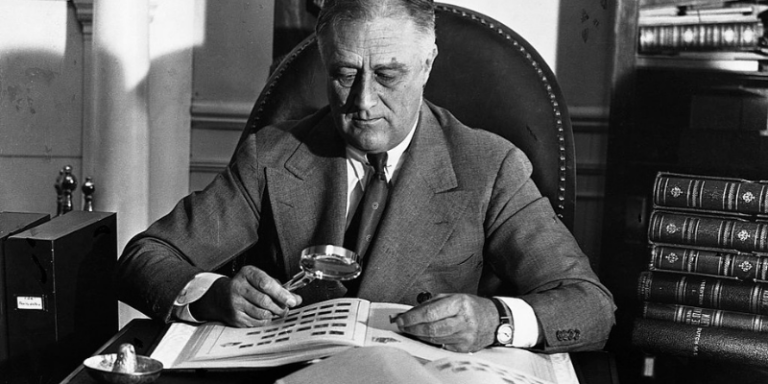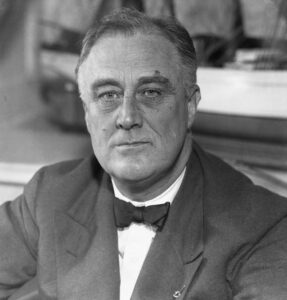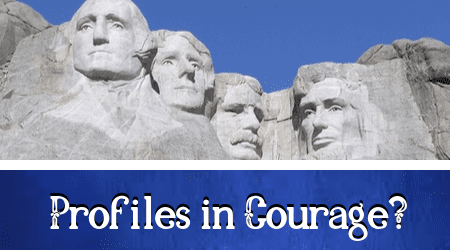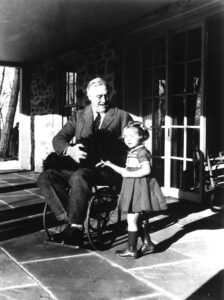FDR: The Four-Term President
FDR won four back-to-back presidential elections – the only president to serve more than two terms.
By: Kelli Ballard | April 12, 2021 | 765 Words

Franklin Delano Roosevelt looks at his stamp collection to distract his attention from the immense pressure which has just erupted as a result of the attack on Pearl Harbor. (Getty Images)
Franklin Delano Roosevelt (1882-1945), or FDR, was the 32nd president of the United States and the only commander in chief to be elected four consecutive terms. Have you heard the saying that the only thing to fear is fear itself? Well, Roosevelt said this during his first inaugural address, at a time the nation was suffering economically as well as recovering from one world war only to be headed towards the second: “This great nation will endure as it has endured, will revive and prosper … [T]he only thing we have to fear is fear itself.”
Early Years
Roosevelt was born on January 30, 1882, in Hyde Park, New York. He was homeschooled until he entered the Groton Preparatory School in Massachusetts at the age of 14. In 1900, he attended Harvard University where he participated more in his social life than his studies. However, it was also at this prestigious school that he became close with his fifth cousin, President Theodore Roosevelt. Franklin married Theodore’s niece, Elanor Roosevelt, who was responsible for opening the future president’s eyes to the poor communities.
During the 1920 presidential election, Franklin was on the ticket as vice president with James M. Cox, but the Democrats lost in a landslide to Calvin Coolidge and Warren G. Harding. And then, in 1932, FDR was elected the 32nd president of the United States.

(Getty Images)
Roosevelt White House
Franklin D. Roosevelt was inaugurated on March 4, 1933. It was a difficult time, as Americans were caught in the middle of the Great Depression with 13 million people unemployed and WWII coming. His inaugural speech in which he said there was nothing to fear but fear itself was the first ever to be broadcast over the radio.
One of the biggest actions the new president took during his first 100 days in office was to close all banks for several days until reform legislation could be passed. Once the Emergency Banking Relief Act was passed, three out of four banks were able to open within a week. Also during this time, he created new legislation for programs and institutions of the New Deal, which provided for economic relief and management. These included the following programs:
- Agricultural Adjustment Administration (AAA)
- Public Works Administration (PWA)
- Civilian Conservations Corps (CCC)
- Tennessee Valley Authority (TVA)
These programs helped to provide economic relief for workers and farmers while also creating jobs for the unemployed.
To help monitor the stock market and prevent the abuses that resulted in the 1929 market crash, he created the following institutions:
- Federal Deposit Insurance Corporation (FDIC)
- Securities and Exchange Commission (SEC)
 In 1935, the economy had started to recover a little, and Roosevelt decided to help it even more. He started a new round of reforms, called the Second New Deal. The Social Security Act provided, for the first time, Americans with a disability and unemployment compensation and pensions for the elderly. The Democrat-led Congress raised taxes on corporations and the wealthy.
In 1935, the economy had started to recover a little, and Roosevelt decided to help it even more. He started a new round of reforms, called the Second New Deal. The Social Security Act provided, for the first time, Americans with a disability and unemployment compensation and pensions for the elderly. The Democrat-led Congress raised taxes on corporations and the wealthy.
Second Term
FDR was re-elected in 1936 despite the Supreme Court opposing many of his New Deal programs. He then proposed expanding the Court to be able to appoint one new justice for every sitting justice that was 70 years old or older, which Congress eventually rejected. Those who opposed the plan called it a “court-packing” scheme. The Court, in order to prevent this packing scheme, reversed course and supported the Social Security Act and several other of FDR’s programs.

(Photo by Margaret Suckley/PhotoQuest/Getty Images)
Third Term
Roosevelt won the 1940 election and in August 1941 he met with Great Britain’s prime minister, Winston Churchill. The two created the Atlantic Charter and declared the “Four Freedoms” on which the post-war world should be founded. These were: freedom of speech and expression, freedom of religion, freedom from want, and freedom from fear.
On December 7, 1941, the Japanese bombed Pearl Harbor in Hawaii, and Roosevelt, with approval from Congress, declared war on Japan.
Fourth Term
Roosevelt was once again re-elected president in 1944 just as the war was starting to turn towards the Allies. The president was already exhausted from his overwhelming job, and he had suffered from polio since the age of 39. In February, he met with Churchill and Joseph Stalin in the Yalta Conference, gaining the latter’s support in the war.
After the conference, FDR was so weak that he could not stand when he addressed Congress. In April 1945, he traveled to his cottage in Warm Springs, Georgia, where he suffered a cerebral hemorrhage. He died on April 12, 1945, and his vice president, Harry S. Truman, became president.
















